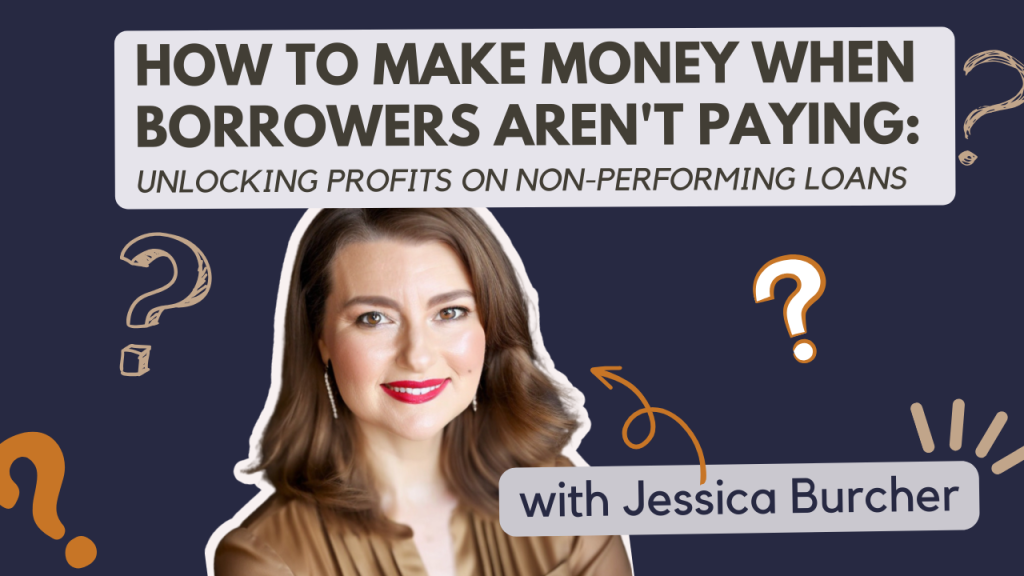A Guide to Passive Real Estate Investment
Today, I wanted to delve into a question that’s been cropping up quite frequently lately: “How do you make money on loans when borrowers are not paying?” Note investing offers an incredible opportunity for earning passive income, but the challenge lies in understanding how to navigate this complex landscape when borrowers stop paying. In a real estate market rife with uncertainty and foreclosure rates on the rise, it’s a valid concern. So, let’s dive deep into this topic and explore the strategies that can help you thrive even when borrowers are struggling to meet their obligations.
Understanding the Situation
First, let’s recap the situation from the perspective of “being the bank.” We are purchasing the mortgage note- the loan that the borrower used to purchase the property, which does use the physical property as the collateral against the loan – so keep that in mind as we go through these next few points.
Securing a Good Deal
When borrowers stop paying their mortgages… banks don’t like it! Many banks, in fact, would rather just sell the loan off… at a substantial discount, than deal with these borrowers. That is where we step in. We purchase these notes from the banks, and because the borrowers are not paying, the banks usually offer a discount – like a hail damage sale. We review these deals- “non-performing mortgage notes” and make offers that factor in the different scenarios that we could employ to see if it makes sense to pursue. So, we’re determining- is it a deal? i.e., will this mortgage bring us a great return on our financial investment as well as our time investment? Or we might discover as we go through these different steps that this is not the deal for us. (Which happens all the time!)
As we review the loan, we run through different scenarios to see what strategy would be the most profitable with the quickest turnaround. What are the different scenarios we look at for loans that borrowers are not paying on? Let’s explore:
Determine the Investment Strategy
1. Can we get the borrower back on track?
Our number one goal is to work with the homeowner to get them current. Keeping homes occupied and keeping owners in their homes brings me not only a sense of joy, but it’s helping to keep that community safe, helping that neighborhood retain property value, and supporting owners get back on their feet, and it is the easiest way to get this investment to a passive-investment-zone, where the homeowner is back to making regular, monthly payments and working towards paying off their mortgage.
Depending on the price you purchase the mortgage note at you usually have a percentage that you can use to help the borrower, and when you start working with the borrower you start looking at:
Does offering them a trial payment plan or a loan modification make sense?
Maybe we are getting such a huge discount on the purchase that helping the borrower by writing off late fees will provide a huge relief and make financial sense.
Sometimes just reaching out to these folks is all it takes. For this process, we always used licensed mortgage servicing agents to make these calls.
2. Cash for Keys
If we can’t get the borrower back on track. A lot of people fall on hard times and just want to move on from a bad situation- sometimes offering cash for keys is a great deal for the homeowner. We offer cash- usually the cost of foreclosure (which we budget into our deal purchase) so they can simply sign over the property to us and walk away.
This saves the borrower from going through foreclosure and damaging their credit, and they have some cash in their pocket to move on to a new place.
This is also a great way for owners who have inherited the home but can’t keep up with property taxes or upkeep to be able to move on.
3. Foreclosure Auction Sale
What if you can’t negotiate a deal with the borrower? Unfortunately, this happens sometimes. To protect ourselves before we even purchase the note, we look at a few factors during our due diligence process including reviewing the state’s foreclose process.
We never purchase notes in states with a long process, and favor states with quick turnarounds like Texas. We budget the cost of an attorney and hold costs for this in our deal as well. The silver lining of this though- we have the opportunity to sell the home at foreclosure auctions, which are very popular with real estate investors, and they offer a quick sale process.
If you are interested in taking a look at our due diligence checklist that takes you through the list of items, we review grab your copy here.
4. Sell the Property
If we do not sell the property at a Foreclosure auction, our next option is to sell the home ourselves- either as is or do some light rehab. We don’t purchase trashed-out properties and would only consider rehabbing if there was a considerable profit to be made. Depending on the market, we can sell the property to real estate investors or even work with local real estate agents to list on the MLS.
5. Become Landlords
Finally, our last option is to become landlords and rent the property out. For me, this would be a worst-case scenario, because my personal goal is to create more passive income and if you’ve ever owned rental property before you know that there can be many headaches involved with having renters. but it is always nice to have an in-case-of-emergency lever to pull, which is why we always review the rent rates for similar properties when performing our due diligence.
Turning Non-Performing Mortgage Notes into Profitable Passive Real Estate Investments
I hope this info provides some clarity on why investing in non-performing notes can still bring a great return on investment – if you have done a thorough due diligence review and have worked through the different exit strategies to make sure you are really getting a deal and not a dude. Partnering with Strategy in Motion makes investing in deals like this a completely passive investment. We secure the deal, perform all the due diligence, work through the exit strategies, and provide an above-average return for our passive investors.
If you would like to grab your copy of our due diligence checklist so you can be more informed as you make your way through building your passive investment portfolio, click here.

